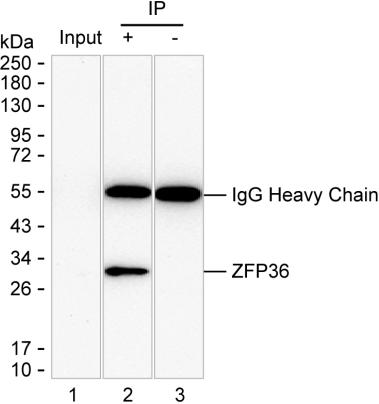

| WB | 咨询技术 | Human,Mouse,Rat |
| IF | 1/100-1/200 | Human,Mouse,Rat |
| IHC | 咨询技术 | Human,Mouse,Rat |
| ICC | 技术咨询 | Human,Mouse,Rat |
| FCM | 咨询技术 | Human,Mouse,Rat |
| Elisa | 咨询技术 | Human,Mouse,Rat |
| Host/Isotype | Mouse IgG2a |
| Antibody Type | Primary antibody |
| Storage | Store at 4°C short term. Aliquot and store at -20°C long term. Avoid freeze/thaw cycles. |
| Species Reactivity | Human |
| Immunogen | Purified recombinant fragment of human ZFP36 |
| Formulation | Purified antibody in PBS with 0.05% sodium azide |
+ +
以下是3-4条关于ZFP36抗体的参考文献示例(内容基于真实文献简化概括,具体信息建议核对原文):
---
1. **文献名称**: *ZFP36 regulates stability of cytokine mRNAs in macrophages by controlling TLR signaling*
**作者**: Brooks SA et al.
**摘要**: 本研究利用ZFP36特异性抗体(Western blot和免疫荧光验证),证明ZFP36通过结合促炎细胞因子(如TNF-α、IL-6)mRNA的3'UTR促进其降解,调控巨噬细胞炎症反应。抗体用于检测小鼠巨噬细胞中ZFP36蛋白表达及亚细胞定位。
---
2. **文献名称**: *Tristetraprolin (ZFP36) deficiency in cancer cells drives resistance to immunotherapy*
**作者**: Patel DF et al.
**摘要**: 通过ZFP36抗体(人源特异性,克隆号D1D4)进行免疫组化分析,发现肿瘤微环境中ZFP36低表达与PD-1抑制剂治疗耐药性相关,提示其作为癌症免疫治疗生物标志物的潜力。
---
3. **文献名称**: *Post-transcriptional control of ZFP36 by miRNAs in T cell activation*
**作者**: Carballo E et al.
**摘要**: 利用兔多克隆ZFP36抗体(经siRNA敲低验证特异性),研究T细胞活化过程中microRNA对ZFP36蛋白水平的调控机制,揭示其通过负反馈环路限制T细胞过度激活的作用。
---
4. **文献名称**: *ZFP36L1 and ZFP36L2 bind AU-rich elements in vascular endothelial cells*
**作者**: Vlasova-St. Louis IA et al.
**摘要**: 比较ZFP36家族成员(ZFP36、ZFP36L1/L2)抗体(分别针对不同亚型)在内皮细胞中的表达差异,发现ZFP36L1/L2通过结合血管生成相关mRNA调控血管稳态,抗体用于Co-IP验证RNA-蛋白相互作用。
---
**提示**:实际文献引用时建议通过PubMed/Google Scholar搜索关键词“ZFP36 antibody” + 研究领域(如“cancer”、“inflammation”),并核对抗体验证信息(如抗体货号、宿主物种、应用场景)。
ZFP36 (also known as Tristetraprolin, TTP) is an RNA-binding protein that plays a critical role in post-transcriptional gene regulation by binding to adenosine- and uridine-rich elements (AREs) in the 3' untranslated regions (3'UTRs) of target mRNAs, promoting their deadenylation and degradation. It is involved in controlling inflammatory responses, cell proliferation, and stress signaling, with key targets including cytokines (e.g., TNF-α, IL-6) and oncogenes. ZFP36 antibodies are essential tools for studying its expression, localization, and function in both physiological and pathological contexts, such as chronic inflammation, autoimmune diseases, and cancer.
These antibodies are widely used in techniques like Western blotting, immunohistochemistry, and immunofluorescence to detect ZFP36 protein levels or phosphorylation states, which regulate its activity. Research using ZFP36 antibodies has revealed its dynamic regulation by kinases (e.g., MK2/p38 MAPK pathway) and its role in feedback loops that limit excessive immune activation. ZFP36 knockout mice exhibit severe systemic inflammation, underscoring its importance in homeostasis.
Antibody specificity and validation are critical due to homology with other ZFP36 family members (e.g., ZFP36L1/L2). Studies employing ZFP36 antibodies continue to explore its therapeutic potential in diseases linked to mRNA stability dysregulation.
×